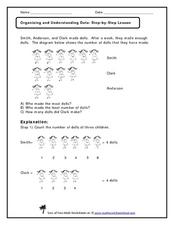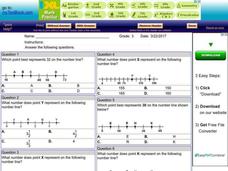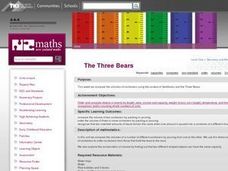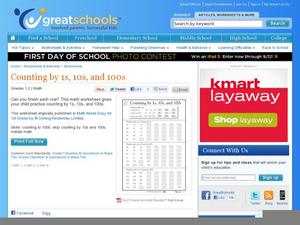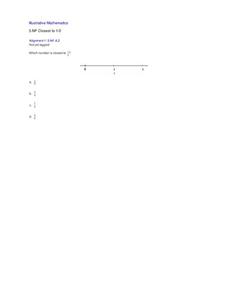Illustrative Mathematics
Find the Missing Number
First graders are asked to find the missing numbers in subtraction and addition equations. Each missing number is represented with a box and appears as an addend, subtrahend, sum, or difference.
Computer Science Unplugged
Count the Dots – Binary Numbers
Did you know you can send a message using only zeroes and ones? This interactive resource presents an introduction to binary numbers. Through code cards, pupils learn to convert binary numbers to decimal numbers.
Curated OER
Organizing and Understanding, Step-by-Step
Use this number comparison and counting worksheet as an overhead projection for the whole class, because the answer is explained on the bottom half of the sheet. Cover the answer and reveal it once learners have tried it themselves. They...
Curated OER
Find 1
Extend your class's ability to represent unit fractions on a number line with this challenging worksheet. Given two number lines, one labeled with zero and 1/4, the other with zero and 5/3, students must accurately locate the number one...
Curated OER
The Branches of Government
After reviewing and reading about the three branches of US Government, complete this activity with your class. In groups, they will place their "cards" on the board under the correct branch. This lesson is weak and unclear. I'd make a...
Curated OER
My Test Book: Number Sense
In this online interactive math skills worksheet, students solve 10 multiple choice math problems regarding number order. Students may view the correct answers.
Curated OER
My Test Book: Number Lines
In this math skills instructional activity, students solve 10 multiple choice math problems that require them to read number lines. Students may view the correct answers.
Curated OER
Represent Mixed Numbers on a Number Line
This number line sequence is missing a few mixed numbers. Scholars determine what the increments are between each segment and use the pattern to complete the sequence. They must count by quarters and write in mixed numbers. Because there...
Curated OER
The Fibonacci Sequence
Students investigate a numerical pattern and look for evidence of mathematical patterns in nature. They solve puzzles and work with a partner to predict sequential numbers in a series.
Curated OER
Compare Numbers to 100: Interactive Online Practice
Offer your little math scholars exhaustive practice comparing numbers (to 100) and using greater than, less than, and equal to symbols. An interactive online resource provides instant feedback. And you get a second chance when your...
Curated OER
The Three Bears: Comparing and Ordering
Students explore comparing and ordering volume of containers. They use the context of Goldilocks and the Three Bears to compare the volume of various containers by packing or pouring.
Curated OER
Number Order
In this number sense worksheet, students solve 5 problems that require them to examine 5 sets of 5 numbers and put them in chronological order.
DK Publishing
Who's First?
Put ribbons, rabbits, and shapes in order with a number sequence activity. Three different activities reinforce counting and number sequence, as kindergartners color particular items and identify the first, second, and third in various...
Curated OER
Identifying Patterns
Although this fractions exercise may seem difficult at first, it's really quite simple and intended for beginners to mixed numbers. Scholars complete 15 number sequences by adding two or three mixed numbers or decimal numbers. However,...
Curated OER
Counting by 3s, 4s, and 5s
Skip count along the mushrooms to complete these number sentences which give young scholars an introductory look at addition and subtraction. Starting from five double-digit numbers, they subtract or add by threes, fours, and fives to...
National Security Agency
Ordering, Adding and Subtracting Integers
Prealgebrarians use colored chips, stickers, and pencils to explore the world of integers. They discover absolute value, compare positive and negative integers, and apply operations to them. A detailed procedure for the three-part...
Curated OER
What Shapes Can You See?
This clown is missing some things, and young counters sequence single-digit numbers to complete this juggling act. They connect four separate connect-the-dots sequences to create two triangles and two squares, then complete three more...
Curated OER
Counting by 1s, 10s, and 100s
These sequences are missing numbers and require some skip counting to complete. Scholars finish rows of numbers first counting by 1s, then 10s, and finally 100s. Each has three given numbers to get them started, and they fill in five...
Curated OER
Position Within a Set
Your learners will have no problem relating to this word problem involving a toy car race: there are three cars, and they come in first, second, and third place in a race down the driveway. Learners analyze the data by writing the...
Curated OER
Patterns of 2s, 5s, and 10s
In order to connect the dots in three images youngsters skip count by twos, fives, and 10s. Encourage them to look for patterns as work, and consider giving out hundreds charts for guidance. They can also color these in once finished!
Curated OER
Closest to 1/2
Using a number line, pupils are asked to identify which of four fractions is closest to one half. Includes a single problem that can serve as a practice problem or formative assessment for 3rd or 4th graders learning to partition number...
Curated OER
Dividing Decimals by Whole Numbers
Dividing decimals is not hard, but one has to know how to manipulate the decimal point in order to achieve correct answers. In this math presentation, learners are taken through the process step-by-step in a clear and concise fashion....
Curated OER
Locating Fractions Greater than One on the Number Line
Supplement your lesson on improper fractions with this simple resource. Working on number lines labeled with whole numbers between 0 and 5, young mathematicians represent basic improper fractions with halves and thirds. The fractions...
Curated OER
Find the Correct Order
By selecting a number in each of three columns to create a series of numbers arranged from least to greatest value, students will apply correct order rules. Slides include practice of ordering 3 and 4 digit numbers, fractions, mixed...


